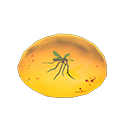Amber
The Amber is fossil display that can be donated to the Museum in Animal Crossing games. It consists of one part. Once the Amber has been donated to Blathers, it will be on display in your Museum.
| Amber Data | |
|---|---|
| Number of Parts | 1 |
| Fossil Parts |
|
| Part Size | 1x1 |
| Fung Shui Color 1 | Yellow |
| Fung Shui Color 2 | Yellow |
| HHA Points | 87 |
| Catalog | Not for sale |
| Sell Price |
|
Amber in Animal Crossing: New Horizons
Amber Fossil Information from Blathers in Animal Crossing: New Horizons
When you donate a Amber fossil to the Museum, Blathers tells you, "Amber is formed from the sap of ancient trees that hardened over time. Because of its beauty, it has often been traded and used as jewelry throughout history. However, individual specimens may contain ancient plants or insects trapped inside them! These are valuable resources for learning about ancient eras, such as when the dinosaurs roamed... And this is why they are sometimes displayed in certain...ahem... exceptional museums! Like mine."
Amber Fossil Price in Animal Crossing: New Horizons
The Amber fossil sells for 1,200 Bells.
How to Get the Amber Fossil in Animal Crossing: New Horizons
You can get the Amber fossil in Animal Crossing: New Horizons by digging up unidentified fossils with a shovel on your island or on a Nook Miles Ticket mystery island. When you take the unidentified fossils to Blathers to assess, there is a chance that the fossil with be a Amber fossil. You can then donate your assessed fossil to the museum to complete your Amber fossil display or use duplicate fossils to decorate, send as gifts to another player or villager, or sell them at Nook's Cranny for extra bells.
Where is the Amber Fossil in the Museum in Animal Crossing: New Horizons?
The Amber fossil display is located in Room 1 of the Fossil wing of the Museum in Animal Crossing: New Horizons. The Amber will only be displayed in the Museum once you have donated it.
Amber Fossil Size in Animal Crossing: New Horizons
The Amber fossil is a 1x1 size item.
Happy Home Academy Information for the Amber Fossil in Animal Crossing: New Horizons
In Animal Crossing: New Horizons, the Amber fossil is worth a base value of 87 HHA points each when displayed in your home. It has a primary color of Yellow and a secondary color of Yellow when the Fung Shui value of your room is being calculated.
Amber Fossil Parts in Animal Crossing: New Horizons
Amber
 |
|
|---|---|
| Amber | |
| Buy Price | NFS |
| Sell Price | 1,200 |
| Interactable | No |
| Filename | FtrFossilAmber |
| ID | 294 |
The Amber fossil has a 1x1 size when placed as a furniture item. When placed in a player's house, the Amber is worth a base value of 87 HHA points, with Fung Shui colors of Yellow and Yellow. The is not an interactable furniture item.
In the Animal Crossing: New Horizon's game code, the Amber has the filename "FtrFossilAmber" and an internal ID number of 294.
Amber in Animal Crossing: New Leaf
In Animal Crossing: New Leaf, you will be able to read the museum plaque for the after donating all of the parts of the fossil. The T. Rex plaque reads, "Amber is simply fossilized tree sap, formed and hardened over many thousands of years. Prized for its beauty, amber is often used in accessories such as necklaces and earrings. Amber containing a trapped insect, such as a bee or ant, can fetch a particularly high price."
You can get the fossil parts in Animal Crossing: New Leaf by digging up unassessed fossils around your town with a shovel at dig spots. Each dig spot has a chance to contain a gyroid, a pitfall seed, or an unassessed fossil. You can take the unidentified fossils to Blathers to assess, and there is a chance that the fossil will be a fossil part. Once you have had Blathers assess the fossils, you can donate your assessed fossils to the museum to complete your or use duplicate fossils to decorate, send as gifts to another player or villager, or sell them at Re-Tail to get some extra bells.
The Amber IRL
Amber is a form of tree resin that has hardened and can contain the remnants of a trapped insect. These unlucky captors become time capsules of information for scientists.
